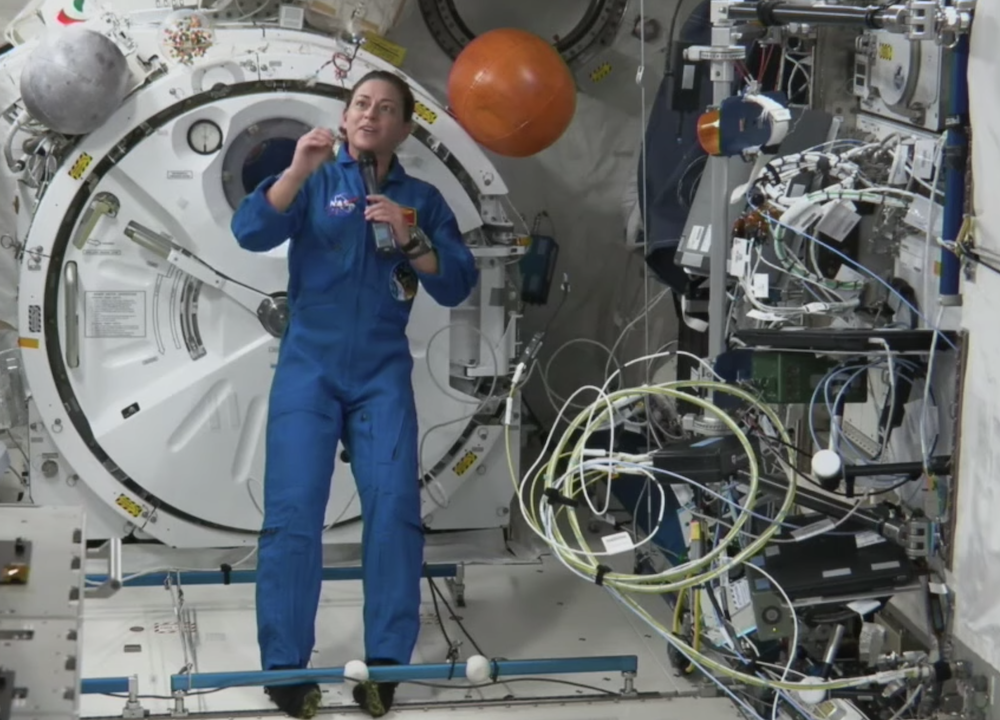
- Details
- By Native News Online Staff
This afternoon, Nicole Aunapu Mann (Wailacki of the Round Valley Indian Tribes), the first Indigenous woman to be launched into space, answered questions from Native American media outlets and Indigenous school children in a live-streamed in-flight interview from the International Space Station.
Mann launched into space earlier this month on Oct. 5. She serves as the mission commander on NASA’s SpaceX Crew-5 space mission on the Dragon spacecraft named Endurance.
The interview was conducted by Associated Press Aerospace writer Marcia Dunn from the Kennedy Space Center in Cape Canaveral.
In answering questions solicited from various Native media outlets and tribal schools, Mann spoke of viewing Earth from space, her career path, and drawing strength from the blessings of her family. At one point, she brought out a dream catcher she carries with her and explained its significance as it gently floated around her in zero gravity.
“I brought a dreamcatcher from my mother that helped me through tough times as a child,” Mann said. “When things are difficult or getting hard, I draw on that strength to continue toward a successful mission.”
When asked if anything from her Wailacki of the Round Valley culture inspired her career, Mann answered, “The biggest thing that inspired me and helped me in my career as an astronaut is the importance of family and community. It’s really important to stay connected and rely on people to help get you through difficult times in life. My parents and my family were a huge foundation for me in preparing me as a young child to persevere through challenges, stay focused in school and giving me confidence and inspiring me to achieve my dreams.”
The interview concluded with Mann answering a question from Native News Online about her message to students at Rounds Valley Indian Tribes Head Start — located on Mann’s reservation — who watched the Oct. 5 launch on a big screen in their classroom.
“I would like to tell them that I appreciate all of the good messages they are sending me,” Mann said. “I appreciate all of their good energy. Please know that I carry all of your hopes and your dreams with me to the International Space Station and I hope for you that you will be able to achieve your dreams, and I pass along the energy for you to be able to persevere in your childhood to do everything you aspire to do in life.”
Watch a recording of the live-streamed interview below or here.
More Stories Like This
Native News Weekly (August 25, 2024): D.C. BriefsUS Presidents in Their Own Words Concerning American Indians
Oral History Project Announces 14th Stop in Portland, Oregon: NABS Continues to Gather Crucial Stories Across Indian Country
Cheyenne River Youth Project Announces Native American Heritage Month Programming, Thanks for Kids Dinner
Monday Morning (November 3, 2025): Articles You May Have Missed This Past Weekend
Help us tell the stories that could save Native languages and food traditions
At a critical moment for Indian Country, Native News Online is embarking on our most ambitious reporting project yet: "Cultivating Culture," a three-year investigation into two forces shaping Native community survival—food sovereignty and language revitalization.
The devastating impact of COVID-19 accelerated the loss of Native elders and with them, irreplaceable cultural knowledge. Yet across tribal communities, innovative leaders are fighting back, reclaiming traditional food systems and breathing new life into Native languages. These aren't just cultural preservation efforts—they're powerful pathways to community health, healing, and resilience.
Our dedicated reporting team will spend three years documenting these stories through on-the-ground reporting in 18 tribal communities, producing over 200 in-depth stories, 18 podcast episodes, and multimedia content that amplifies Indigenous voices. We'll show policymakers, funders, and allies how cultural restoration directly impacts physical and mental wellness while celebrating successful models of sovereignty and self-determination.
This isn't corporate media parachuting into Indian Country for a quick story. This is sustained, relationship-based journalism by Native reporters who understand these communities. It's "Warrior Journalism"—fearless reporting that serves the 5.5 million readers who depend on us for news that mainstream media often ignores.
We need your help right now. While we've secured partial funding, we're still $450,000 short of our three-year budget. Our immediate goal is $25,000 this month to keep this critical work moving forward—funding reporter salaries, travel to remote communities, photography, and the deep reporting these stories deserve.
Every dollar directly supports Indigenous journalists telling Indigenous stories. Whether it's $5 or $50, your contribution ensures these vital narratives of resilience, innovation, and hope don't disappear into silence.
 The stakes couldn't be higher. Native languages are being lost at an alarming rate. Food insecurity plagues many tribal communities. But solutions are emerging, and these stories need to be told.
The stakes couldn't be higher. Native languages are being lost at an alarming rate. Food insecurity plagues many tribal communities. But solutions are emerging, and these stories need to be told.
Support independent Native journalism. Fund the stories that matter.
Levi Rickert (Potawatomi), Editor & Publisher

